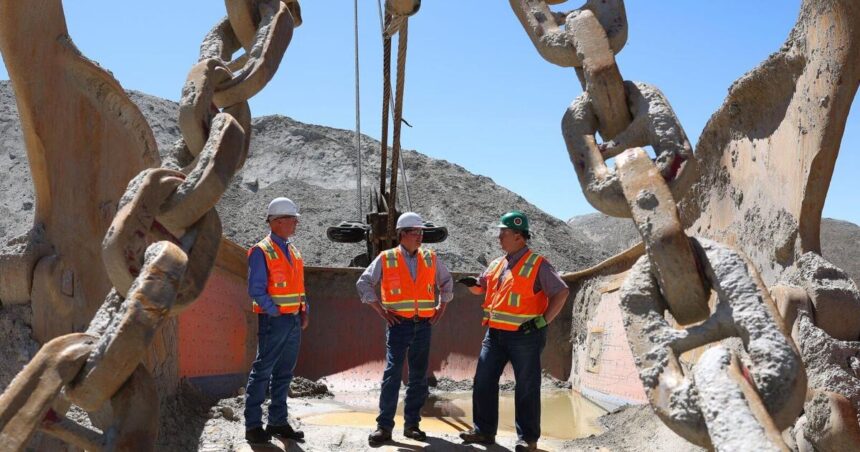COLSTRIP — Actions by President Joe Biden’s administration that could hasten closures of heavily polluting coal power plants and the mines that supply them are reviving Republican rhetoric about a so-called “war on coal” ahead of the November election.
The front line in the political battle over the fuel is in the Powder River Basin of Wyoming and Montana, a sparsely populated section of the Great Plains with the nation’s largest coal mines. It’s also home to a massive power plant in Colstrip, Montana, that emits more toxic air pollutants such as lead and arsenic than any other U.S. facility of its kind, according to the Environmental Protection Agency.
The EPA last month finalized a suite of rules that could force the Colstrip Generating Station to shut down or spend an estimated $400 million to clean up its emissions within the next several years. Another proposal, from the U.S. Interior Department, would end new leasing of taxpayer-owned coal reserves in the Powder River Basin, clouding the future of mines including Westmoreland Mining’s Rosebud Mine that provides about 6 million tons of fuel annually for Colstrip.
People are also reading…
Eight years ago during his first White House run, Donald Trump stoked populist anger against government regulation by highlighting anti-coar actions taken under former President Barack Obama. The latest moves against coal have opened up the issue again for Republicans aiming to defeat Biden in the November election. Some coal-state Democrats also share concerns.
“This onslaught of new rules is going to kill jobs and will kill communities like Colstrip,” Montana Republican Sen. Steve Daines said during a visit to Rosebud Mine this week with Republican Gov. Greg Gianforte. “What will change this outcome is an election and a new administration.”
U.S. coal consumption dropped significantly over the last ten years as inexpensive natural gas and renewables expanded. However, coal’s political impact persists as opponents strive to further limit the burning of the fuel that is a major contributor to climate change and air pollution.
It continues to be a crucial economic driver in communities like Colstrip, providing jobs where workers can earn $100,000 annually, according to union officials.
The Biden administration defended the recent coal restrictions as essential to reducing harmful pollutants, enhancing public health, and addressing court rulings on climate change.
A representative from the Biden campaign mentioned that coal’s decline continued during Trump’s presidency.
“There is no war on coal, there is only a fight for our energy future,” campaign spokesperson James Singer said. “Under President Biden, the United States is closer to energy independence than we have been in decades.”
Despite the ban on new coal leases, companies currently hold leases for over 4 billion tons of coal on federally-owned lands. Administration officials claim that this is enough to support mining for many years.
Supporters argued that the crackdown on pollution from coal plants has been long overdue. It stemmed from amendments to the Clean Air Act in 1990 that tasked the EPA with establishing standards for pollution reduction technologies.
Dr. Robert Merchant, a pulmonologist from Billings, stated that research data clearly links pollution from Colstrip and other plants to medical issues such as cancer, developmental delays in children, and heart attacks.
“The problem with Colstrip or any large industry like that is they’re very good at understanding the economics as it impacts their balance sheets and bottom line,” Merchant said. “Unfortunately, the health effects are not appearing on their bottom line.”
Representatives of the Northern Cheyenne Tribe had urged the Biden administration to enforce pollution rules to safeguard air quality on their reservation just south of Colstrip.
The plant commenced operations in the mid-1970s and underwent expansion later on. It looms over Colstrip, a town with about 2,000 residents. It is connected to the Rosebud Mine by extensive conveyor belts that carry coal to the 1,480 megawatt plant, where it is burned to produce electricity for distribution across the state.
Brian Bird, president of Colstrip co-owner NorthWestern Energy, argued that characterizing Colstrip as the “highest emitter in the country” by EPA Administrator Michael Regan during Congressional hearings was misleading due to the plant’s size — one of the largest coal plants west of the Mississippi River. Bird claimed that Colstrip was “in the middle of the pack” in terms of pollution per megawatt of power generated.
Some prominent Democrats expressed that federal agencies are moving too swiftly and aggressively against coal.
Montana Democratic Sen. Jon Tester stated that the EPA rules “missed the mark” as it could entail hundreds of millions of dollars for Colstrip to comply. In West Virginia — the second largest coal producer after Wyoming — Democratic Sen. Joe Manchin accused Biden of attempting to “score short-term political points” by implementing the new rules in an election year.
Tester is viewed as one of the most vulnerable Democrats in the Senate ahead of the election, with Republicans needing only two more seats to regain control of the chamber.
His Republican opponent, Tim Sheehy, criticized the “Biden Tester climate cult” following the announcement of the ban on new coal leases. Tester’s spokesperson, Eli Cousin, mentioned that the lawmaker was still reviewing the administration’s proposal.
Manchin is not seeking reelection when his term concludes in January. Republican Gov. Jim Justice is running for the seat, and the EPA rules could potentially sway voters in his favor as he competes against Democrat Glenn Elliott, the mayor of Wheeling, West Virginia.
Elliott has advocated for increased green energy in West Virginia but has not commented on the EPA rules.
EPA officials pledged to collaborate with the owners of the Colstrip plant “to help them find a path forward” in response to concerns raised by Tester and other legislators. The agency indicated that 93% of coal-fired plants had demonstrated their ability to conform to the new air pollution standards.





